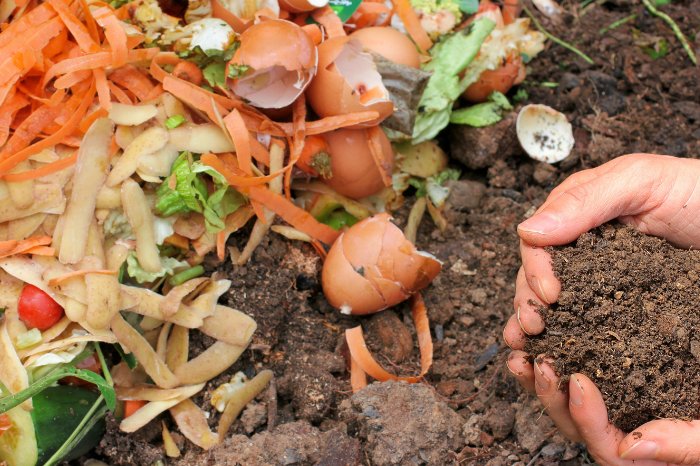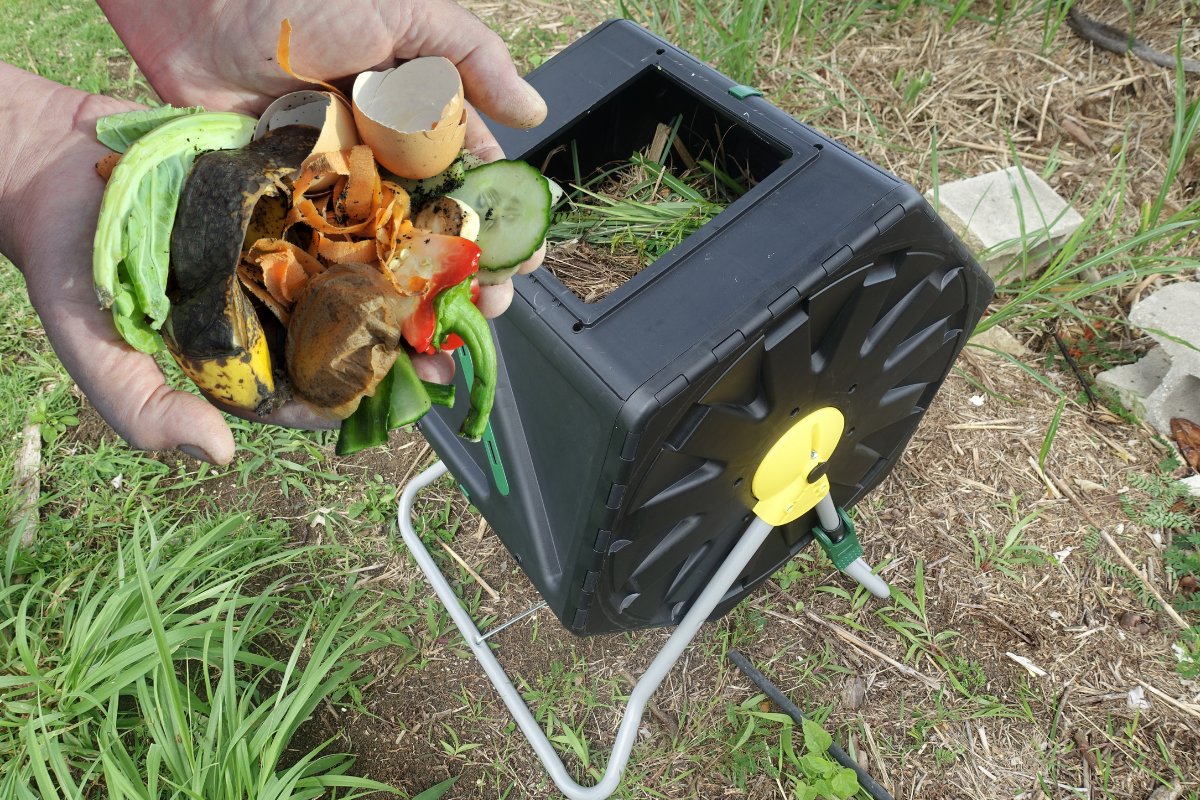Last Updated on December 20, 2022 by Cristina
In this article, we look at how to start a compost tumbler. For small gardens where you are space limited, a compost tumbler makes relatively high-quality compost efficiently, and without too many smells. Read more to learn how to start a compost tumbler and nourish your garden with fine, clean compost.
What Is Compost? – How To Start A Compost Tumbler
When organic matter decays it goes through an active phase of rapid decay – this is normally accompanied by some heat generation – after this, you have decayed organic matter – we refer to this as compost – over time compost further degrades and gives us humus which is highly degraded organic matter that builds up in the soil over millennia. That is the dark stuff in rich loam.
During the early stage of the composting process, a lot of heat can be generated – and in some cases, if compost gets a bit wet – it smells. In fact, if a compost heap that is rich in grass clippings gets too wet it smells exactly like the innards of a cow – which is basically the same thing. Cows are full of rotting grass.
In this regard, making compost in such a way that it can remain aerated, and not get too wet is an ideal option for small gardens. This is where the compost tumblers come into play. When considering how to start a compost tumbler we must remember the above information.

What Is A Compost Tumbler And Why Do You Need One?
A compost tumbler consists of some sort of drum that can be filled with the material to compost and then rotated periodically. This helps mix the organic matter up and keeps the compost aerated and not smelly. It supposedly speeds up the composting process, but I find this to not have been the case in the four models I tested.
If you have a big garden you do not need a compost tumbler. I often get called by people to remove bees from compost tumblers, and these are normally gifts they have received for a birthday or Christmas. In larger gardens, these tumblers just cannot keep up with the volumes of organic matter that need to be composted, and more often than not, much like compost bins, they get left in a corner.
I consequently have had quite a few of these pass through my hands, have played with them a bit, and then sent them on to folks with small gardens who can use them. In this process, I learned how to start a compost tumbler using my Ph.D. in microbiology as a guide. In a large garden, just making a heap of compost in the corner and letting nature do its thing works fine. I actually just cover my whole garden in a few feet of leaves and wood chips as mulch per year and compost in situ – that helps nourish my plants more.
When I say a compost tumbler is ideal for a small garden I mean a garden that is in the 100 to 800 or so square feet range. Anything above this size will produce more organic waste than a tumbler can possibly process and you should consider other methods.
How To Start A Compost Tumbler
The composting process can be looked at as a bit of a relay involving many different bacteria, fungi, and creatures. Each one plays its own unique role and passed the process on to the next. The composting process can occur in an aerobic fashion (desirable) meaning that there is oxygen present and the creatures growing enjoy some oxygen. Or it can occur in an anaerobic process – this means that there is not enough oxygen and the bacteria have become dominant – and this will smell. By turning your tumbler you constantly mix oxygen into the mixture and favor the less smelly composting process that uses air. This process is also faster.
When we start a compost tumbler we ideally need to add (innoculate) microbes into the tumbler. You can buy a compost activator. I do however also feel that it is an excellent idea to collect little handfuls of compost from flower beds and parks you may go to where there is some rotting organic matter. You need a huge biodiversity of microbes to have a stable composting process, hence sampling a wide range of different environments and incorporating these microbes into your compost enhances the efficacy of the tumbler.
Compost-It Compost Accelerator / Starter 100g Spout Pack for All Composting Systems
How To Use A Compost Tumbler
Place a mixture of leaves, grass clippings, kitchen scraps, and your compost activator into your tumbler. Follow the instructions for the specific model you have in terms of how much to fill it. As suggested earlier, when learning how to start a compost tumbler, try to incorporate some compost and topsoil, and forest humus into the compost maker too! Biodiversity is what makes compost work – you need thousands of species of bacteria and fungi to make truly great soil. I know this because I am a microbiologist and I work on microbial consortia – massive clusters of yeast and bacteria that work together. The more species, the better generally.
How To Compost In A Tumbler Once It Is Up And Established
Once you have established your compost tumbler you can keep 10% of the compost you have made in the tumbler and remove the rest – this 10% acts as a starter for the next batch of compost you make. As the microbial population adapts to your conditions your composting process will become faster and faster, and the quality of your compost will improve.
How Long Does It Take To Compost In A Tumbler?
My general observation is that in my conditions I can make compost in about a month and a half in a compost heap and two months in the tumbler. The quality and fineness of the compost from the compost maker are greater, and it does not smell as much as a compost heap can.
You will find that brochures for various products tell you that you can make good compost in a month – I think discounting this as marketing mumbo jumbo is a good idea. The reality is that composting is a process that requires certain chemical pathways to run – and there is a limit to how fast these can happen at low temperatures. So yes, you can probably make compost in three weeks in the Congo where it is 105°F day and night using one of these tumblers, but in middle latitudes work on 6-8 weeks as a good time frame on average.
What Is The Best Compost Starter For Tumblers?
There are many starters out there – they all contain a mix of microbes and nutrients. This is a good example. The real thing to understand is that you cannot buy the best starter. You build one of these up for yourself with time. So you can buy a starter, and also keep a little bottle in your pocket or bag, and whenever you see a nice flower bed or are walking in a forest, take a small sample – a teaspoon of soil is fine – of natural compost and add this to your compost maker. With time, you will build up a better and better consortium of microbes in your compost maker.
Do not be afraid to include manure, chicken poop, bird poop, and so on in the system either. These are all rich sources of microbial biodiversity. The more microbes, the greater the chance that one of them has the enzymes needed to break down the papaya skin, banana skin, or avocado skin that you add to the compost maker. Diversity of species equals diversity of capabilities.
In Conclusion – How To Use A Compost Tumbler
These machines are suited to small gardens and make compost that does not stink too much during the process. Follow the specific instructions for the tumbler you buy – do not believe the marketing rubbish they tell you – it will take longer to make compost than they say. You can speed the process up by using a compost starter that you can buy and supplementing this with samples of compost, soil, humus, and leaf litter that you can collect and add to the system ensuring the greatest microbial biodiversity. Enjoy!!
Dr. Garth A. Cambray is a Canadian/South African entrepreneur and beekeeper with 28 years of experience in apiculture and specializes in adding value to honey. His Ph.D. research developed a new advanced continuous fermentation method for making mead that has resulted in a number of companies globally being able to access markets for mead. His company, Makana Meadery, exports honey mead to the USA where it is available to discerning connoisseurs. He has also developed technologies to commercially manufacture organic honey vinegar in Zambia for export globally. He holds a few patents globally in the ethanol industry and believes in technology and knowledge transfer for human development and environmental sustainability. One of his proudest achievements is the fact that the wind farm he started at one of his old apiary sites has essentially made his hometown carbon neutral.



